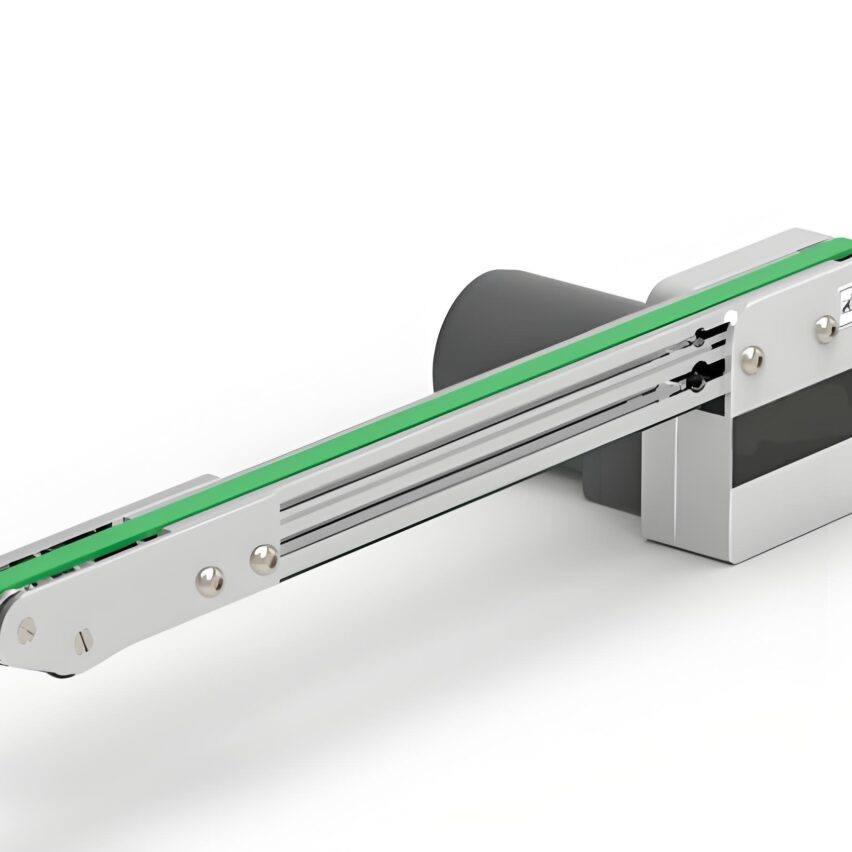I. The core principle of the multiplier chain: synergistic evolution of speed and precision
The mystery of the "multiplication" of the speed chain comes fromDouble Diameter Roller Structureof mechanical design:

- Internal chain roller(diameter d): contact with the guideway to form the base velocity V₁
- External Chain Roller(Diameter D, D>d): additional speed due to friction with the workpiece plate
According to the motion superposition formulaTotal V = V₁ x (1 + D/d)The speed of the pallet can be up to 3 times the speed of the chain when D=2d. This design is based onLow energy consumption chain driverealiseHigh-speed material handlingThe motor load is reduced to 40% or more, while avoiding positioning deviation caused by high-speed vibration.
Real-world optimisation of spraying scenarios::
A home appliance factory has been able to accurately intercept workpieces within 0.5 seconds through dynamic stopping technology:
- Adaptive spray angle adjustment for shaped surfaces
- Coating thickness fluctuation ≤±2μm
- Reduced cleaning time for colour change 60%
II. Supporting equipment systems: evolution from single conveyor to integrated ecology
1.Synergy matrix of functional modules
| kit | core functionality | Industry Cases |
|---|---|---|
| jack-up transplanter | Enables 90° cable changes/multi-layer transfers | Automotive dashboard double-layer assembly line |
| Power drum transition section | Convergence of different conveyor beats | Lithium battery PACK line |
| Electrostatic adsorption work plate | Anti-dispersion of small workpieces (±5000V) | Mobile phone motherboard chip line |
| Explosion-proof rail | Flame retardant grade ExdⅡCT4 | New energy battery box coating line |
2.Three-tier architecture of the intelligent control centre
plaintextmake a copy of[Device layer]: PLC + high precision sensor (±0.05mm positioning) │ [Execution layer]: MES scheduling system (dynamic adjustment of work station beats) │ [Decision layer]: AI capacity optimisation model (predictive maintenance reduces 70% failures)case (law): With this system, the Suzhou plant has reduced energy consumption by 0.34 RMB per piece conveyed.
Third, industry application scenarios: from heavy load to precision adaptation breakthroughs
Automotive Manufacturing
- Great Wall Motor CustomisationDouble Speed ChainWider and thicker design of the work plate, load bearing 2.2 tonnes engine block.
- collocationElevator linkage systemVertical conveying of materials in a three-storey workshop
3C Electronics
- Mobile phone assembly line usingElectromagnetic Reducing RollerAutomatic switching of light/heavy load modes (200kg→40kg)
- Millimetre positioning accuracy guarantees screen assembly yield of 99.2%
New Energy Sector
- Tennant GroupTotally enclosed dust-free multiplier chainBattery Cell Dust Pollution Reduction 90%
- Anti-static tray + ceramic coated rollers to avoid the risk of sparks in lithium battery production
IV. Supporting configuration strategies for SMEs
Cost-sensitive programmes(Investment <$500,000):

- Line length: 10-15 metres for a single section (to avoid excessive lengths leading to chain slack)
- driving power: 2.2kW Shingo geared motor (supports 220V)
- expansion module: Detachable lighting socket + pneumatic stopper
Space optimisation tips::
Changzhou Guangliang's 16m compact multiplier chain for VinFast Vietnam, laid out through an S-curve:
- Realisation of the original 500m2 capacity in a 300m2 workshop
- Workstation spacing compressed to 1.2 metres (1.5 metres required for standard lines)
V. Future trends: flexible manufacturing and the green revolution
Digital twin pre-commissioning
Production line previewed in virtual environment of Qingdao factory, thermal deformation compensation algorithm enables 12m chain runout <0.1mm, new model introduction cycle time from 14 days → 3 days.Bio-based Composites
DuPont 2025 launchPolyamide rollers::
- Carbon Footprint Reduction 53%
- Abrasion resistance 3 times higher than engineering plastics
The Maglev Drive Revolution
The contactless transmission scheme in the test:
- Energy consumption reduced by 40% compared with conventional motors
- Complete elimination of chain wear dust
Self-questioning: core concerns of the multiplier chain support system
Q1: How to choose between 2.5x chain and 3x chain?
A: Light load environment (≤200kg) choose 2.5 times speed chain (measured growth rate 2.3 times), heavy load scenario (≥1 tonne) with 3 times speed chain (measured 2.7 times) - friction loss makes the theoretical value discounted by 90%.Q2: Why is the maintenance cost lower than a belt line?
A: Triple self-maintaining design:
- Self-lubricating kit(Extended oil change intervals to 1 year)
- wear bar(50,000 hours of anti-dust abrasion life)
- Automatic tension adjustment(Reduction of manual inspections 60%)
Q3: What are the advantages over traditional drum lines?
A: The multiplier chain is inDynamic assembly scenariosIrreplaceable:
- Positioning accuracy of roller line ±2mm → Bevelling chain ±0.05mm
- backingsynchronous accumulation of discharges(Roller lines need to be stopped)
- Low energy consumption 40% (motor power ≤ same load drum line)
While the manufacturing industry is still debating whether "efficiency and flexibility can co-exist", the Speed Chain system has already been used in the manufacturing industry.Space Utilisation Enhancement 200%, andUnit energy consumption down 34%The data from the conveyor line has reconfigured the logic of production - it has transformed the conveyor line from a cost centre into an "efficiency value-add" in the smart factory.














